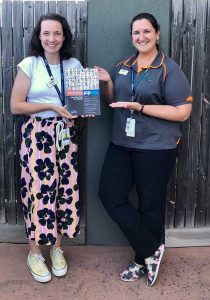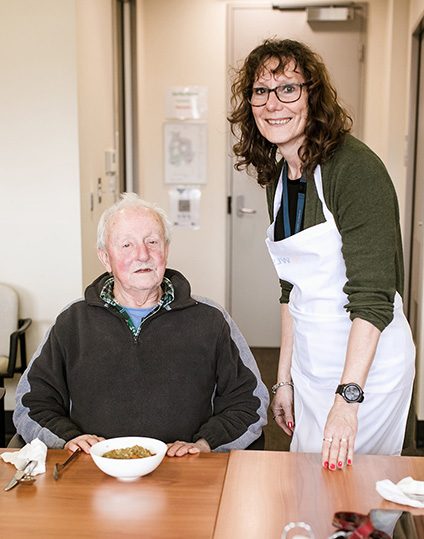At Latrobe Community Health Service, we pride ourselves on delivering services that are evidence-based and outcomes-focused.
Research opportunities are therefore an integral part of our organisation. We support research that informs our practice, and that has the potential to deliver better health outcomes for our clients.
We continue to broaden our relationship with tertiary and vocational education providers, who help us achieve a vibrant research program.

Research Council
The Latrobe Community Health Service Research Council guides, monitors and supports research and advises on external requests for research collaborations.
The Council consists of Latrobe Community Health Service employees, as well as academics from partnering education providers such as Monash University, Federation University, and The Cairnmillar Institute.
Academics support the research process at Latrobe Community Health Service, and help our staff to develop their research question and to conduct a literature review.
Support to complete an ethics proposal is also available. Staff have access to the resources of the Latrobe Regional Hospital library. The Latrobe Regional Hospital librarian offers training in searching databases and will assist staff to develop their library access skills.
Previous research
Read the following case studies for examples of our research projects.
Reducing waiting times for occupational therapy
 Increased demand for community-based occupational therapy has led to longer waiting times in the Latrobe Valley, regional Victoria.
Increased demand for community-based occupational therapy has led to longer waiting times in the Latrobe Valley, regional Victoria.
In response, a team of occupational therapists and allied health assistants at Latrobe Community Health Service developed the Basic Assessment Model (BAM). This was designed to reduce the waiting time for occupational therapy, and increase the number of people accessing this service.
Latrobe Community Health Service occupational therapists developed the Basic Assessment Model (BAM) pre-screening tool to decrease waiting times. The BAM was designed to increase the use of allied health assistants when supporting non-complex clients, meaning occupational therapists could see more people sooner.
Under the new model, the allied health assistant completes the following tasks:
- Screening assessments when booking appointments
- Additional equipment trials
- Monitoring home modifications
- Checking in on clients following new equipment or home modification
- Closing client files when all goals are completed (as directed by the occupational therapist).
The allied health assistant uses the BAM screening tool to collect initial background information and identify any basic equipment the client might need. The occupational therapist then takes this equipment and completes home modification diagrams that are sighted and approved by clients during home visits. This ensures timely interventions and modifications are made while potentially eliminating the need for more visits.
We undertook a quantitative comparative study pre-and post-implementation of BAM to understand whether BAM led to shorter waiting times for occupational therapy.
The BAM was introduced in March 2018, with pre-and post-data collected either side of the implementation period.
Researchers found:
- There was a significant decrease in the waiting time for occupational therapy after BAM was implemented.
- The number of occupational therapy assessments also increased under the new model.
The results of this study show waiting lists for community occupational therapy services can be reduced and the number of assessments undertaken daily can be increased by implementing a BAM.
The BAM is now fully integrated into Latrobe Community Health Service’s community-based occupational therapy service.
This research was first published in the Australian Journal of Rural Health.
Therapeutic gardening improves quality of life
 Therapeutic day rehabilitation (TDR) at Latrobe Community Health Service is a non-residential, structured rehabilitation program designed for people recovering from substance misuse. The program helps people to learn relapse-prevention skills, build life skills and improve their general wellbeing.
Therapeutic day rehabilitation (TDR) at Latrobe Community Health Service is a non-residential, structured rehabilitation program designed for people recovering from substance misuse. The program helps people to learn relapse-prevention skills, build life skills and improve their general wellbeing.
A growing number of evidence shows exposure to nature and therapeutic gardening can enhance our health and wellbeing and provide psychological benefit. We introduced therapeutic gardening into the TDR program, and studied its impact on participants’ quality of life.
We examined the longitudinal impact the TDR program had on participants’ quality of life, and explored their perceptions of the overall program, including the gardening component. Specifically, we aimed to answer the following three questions:
- Is there a significant difference in the participants’ quality of life before the program, at the end of the program, and at four weeks follow up?
- What are the perceptions of participants on their experiences with the TDR program?
- What are the perceptions of participants engaging with therapeutic gardening?
We employed a convergent parallel mixed-method design for this research.
We assessed participants’ quality of life using a psychometric tool. We did this at three time points: start of program, end of program, and four weeks post program completion.
An experienced researcher, external to the TDR program, conducted semi-structured interviews with participants about their experience in the program and the gardening component.
Researchers analysed the data to determine if there was a significant difference in participants’ quality of life. They analysed interview transcripts to generate themes that told the stories of the participants’ experiences with the program.
The analysis showed there was a significant increase in the participants’ quality of life after completing the program. Quality of life improved in three areas: physical health, psychological, and social relationships. These observed changes were retained at follow-up four weeks later.
Four themes emerged from the interviews: participants spoke about building social connections, providing structure and a sense of achievement, better understanding of recovery, and relaxation from accessing nature in the therapeutic gardening component.
Having access to a garden, working within it, and being responsible for the garden was a new experience for several participants in this study. Participants enjoyed doing activities in the garden, which they perceived as meaningful, and gave them a sense of achievement.
Overall, the research findings highlighted the success of this TDR program in helping people gain a better understanding of their recovery. Participating in the TDR gave them a purpose, and it decreased their social isolation by meeting peers with similar experiences.
This research was first published in the Australian Journal of Primary Health.
Evidence-based improvements in speech therapy
 Latrobe Community Health Service delivers a multidisciplinary allied health service for families of children experiencing mild-to-moderate developmental delay.
Latrobe Community Health Service delivers a multidisciplinary allied health service for families of children experiencing mild-to-moderate developmental delay.
Our paediatrics team provides early intervention in the areas of communication; social, emotional, and behavioural skills; sensory processing; and fine and gross motor skills.
Our paediatric speech pathologists deliver behavioural treatment therapy to target children’s stuttered speech using the Lidcombe Program. This relies on parents managing their children’s stuttering in different environments, including delivering the therapy and rating their child’s stuttering severity at home using a paper-based system.
In this study, we tested whether a newly-developed online tool and reminder system made it easier for parents and speech pathologists to implement the program.
The aim of this study was to compare the traditional paper-based severity rating system to a newly-developed online tool. The study also reported on the outcomes of a newly-introduced daily reminder text message.
These were the specific research questions:
- Which of the two systems – traditional paper-based or the newly-developed online system – did caregivers prefer to use in rating their child’s stuttering?
- How does a daily reminder text impact caregiver adherence to the Lidcombe Program?
We asked primary caregivers of children participating in the Lidcombe Program to fill in their child’s daily stuttering severity ratings on the traditional paper forms. Eight weeks into the program, we gave the primary caregivers a new online system – developed by Latrobe Community Health Service speech pathologists. We also sent an evening text message to remind caregivers to rate the severity of their child’s stuttering for that day.
We surveyed caregivers about their perceptions of the two rating systems. Our speech pathologists analysed the use of the two rating systems.
All respondents preferred to use the online stuttering rating system compared to the paper system. All participants also rated the text message reminder as useful.
From a clinical perspective, the online system allowed clinicians to determine how often ratings were being completed by caregivers (for example, daily or every few days).
This study demonstrated that monitoring and evaluating caregiver feedback can initiate change and result in enhanced efficiency and effectiveness of a service. Latrobe Community Health Service speech pathologists continue to use this approach when delivering the Lidcombe Program.
This research was first published in the Journal of Clinical Practice in Speech-Language Pathology, a major clinical publication of the Speech Pathology Association of Australia.
Download the research journal article
Enquire now
For enquiries about research opportunities, please phone 1800 242 696 or email the Placement, Education and Research Unit.



